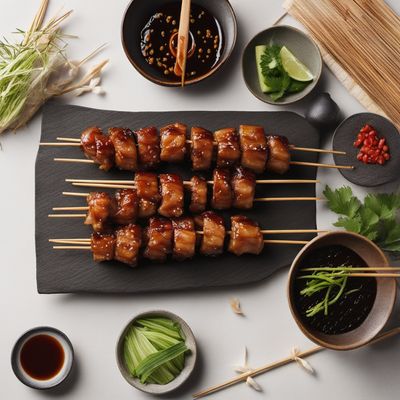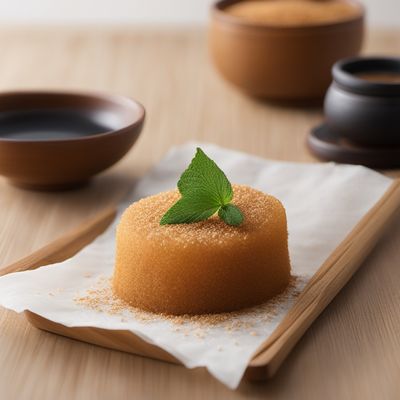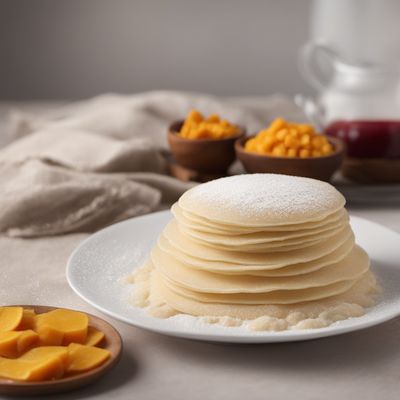
Recipe
Zunda Mochi with a Schleswig-Holstein Twist
Green Bean Mochi Delight: A Fusion of Japanese and Schleswig-Holstein Flavors
4.6 out of 5
Indulge in the unique fusion of Japanese and Schleswig-Holstein cuisines with this delightful Zunda Mochi recipe. Combining the traditional Japanese sweet treat with the flavors of Schleswig-Holstein, this dish offers a harmonious blend of textures and tastes.
Metadata
Preparation time
30 minutes
Cooking time
10 minutes
Total time
40 minutes
Yields
4 servings
Preparation difficulty
Medium
Suitable for
Vegetarian, Vegan (if using plant-based butter), Gluten-free, Dairy-free, Nut-free
Allergens
Dairy (if using butter)
Not suitable for
Paleo, Keto, Low-carb, High-protein, Atkins
Ingredients
In this adaptation, we replace the traditional edamame beans with locally sourced green beans from Schleswig-Holstein. The green bean paste is prepared using a combination of Schleswig-Holstein butter, sugar, and a hint of vanilla extract, giving it a rich and creamy flavor. Additionally, we garnish the dish with a sprinkle of sea salt, which adds a savory element that complements the sweetness of the mochi and zunda paste. We alse have the original recipe for Zunda mochi, so you can check it out.
-
2 cups (400g) glutinous rice flour 2 cups (400g) glutinous rice flour
-
1 1/2 cups (355ml) water 1 1/2 cups (355ml) water
-
1 cup (200g) Schleswig-Holstein green beans, cooked and peeled 1 cup (200g) Schleswig-Holstein green beans, cooked and peeled
-
1/4 cup (50g) Schleswig-Holstein butter 1/4 cup (50g) Schleswig-Holstein butter
-
1/2 cup (100g) granulated sugar 1/2 cup (100g) granulated sugar
-
1/2 teaspoon vanilla extract 1/2 teaspoon vanilla extract
-
Sea salt, for garnish Sea salt, for garnish
Nutrition
- Calories (kcal / KJ): 320 kcal / 1340 KJ
- Fat (total, saturated): 8g, 5g
- Carbohydrates (total, sugars): 60g, 20g
- Protein: 4g
- Fiber: 2g
- Salt: 0.2g
Preparation
-
1.In a large bowl, combine the glutinous rice flour and water. Mix well until a smooth dough forms.
-
2.Divide the dough into small portions and shape them into round balls. Set aside.
-
3.In a food processor, blend the cooked green beans until smooth.
-
4.In a saucepan, melt the Schleswig-Holstein butter over low heat. Add the green bean paste, sugar, and vanilla extract. Stir until well combined and the sugar has dissolved.
-
5.Remove the saucepan from heat and let the green bean paste cool slightly.
-
6.Take each rice ball and flatten it into a small disc. Place a spoonful of the green bean paste in the center of the disc.
-
7.Fold the edges of the rice disc over the filling, sealing it completely. Repeat with the remaining rice balls and green bean paste.
-
8.Sprinkle the mochi with a pinch of sea salt for garnish.
-
9.Serve the Zunda Mochi immediately and enjoy!
Treat your ingredients with care...
- Green beans — Make sure to cook the green beans until they are tender but still vibrant green in color. Overcooking can result in a dull appearance and loss of flavor.
Tips & Tricks
- If you prefer a smoother texture, you can strain the green bean paste after blending to remove any fibrous bits.
- For a more pronounced Schleswig-Holstein flavor, you can add a splash of local schnapps to the green bean paste mixture.
- If you don't have glutinous rice flour, you can substitute it with regular rice flour, but the texture of the mochi may be slightly different.
- To prevent the mochi from sticking, lightly dust your hands with cornstarch or potato starch while shaping the rice balls.
Serving advice
Serve the Zunda Mochi as a delightful dessert after a Schleswig-Holstein-inspired meal. It can be enjoyed warm or at room temperature.
Presentation advice
Arrange the Zunda Mochi on a beautiful plate or platter, allowing the vibrant green color of the zunda paste to stand out. Sprinkle a pinch of sea salt over the mochi for an attractive finishing touch.
More recipes...
For Japanese cuisine » Browse all
More Japanese cuisine dishes » Browse all

Hirame nigiri sushi
Fluke Nigiri
Hirame nigiri sushi is a type of sushi that consists of a small ball of sushi rice topped with a piece of flounder. It is a popular sushi dish...

Yaki imo
Yaki Imo
Yaki imo is a Japanese sweet potato that is roasted over an open flame until it is soft and caramelized.

Onigiri
Onigiri is a Japanese rice ball that is often filled with various ingredients such as salmon, tuna, or pickled vegetables. It is a popular snack...









